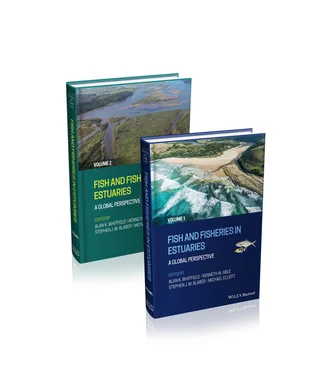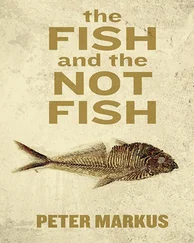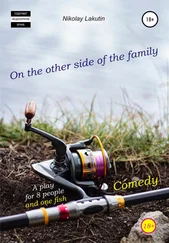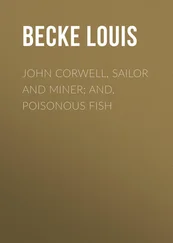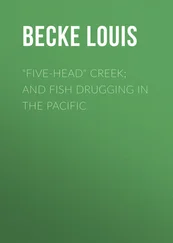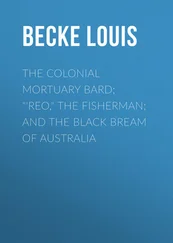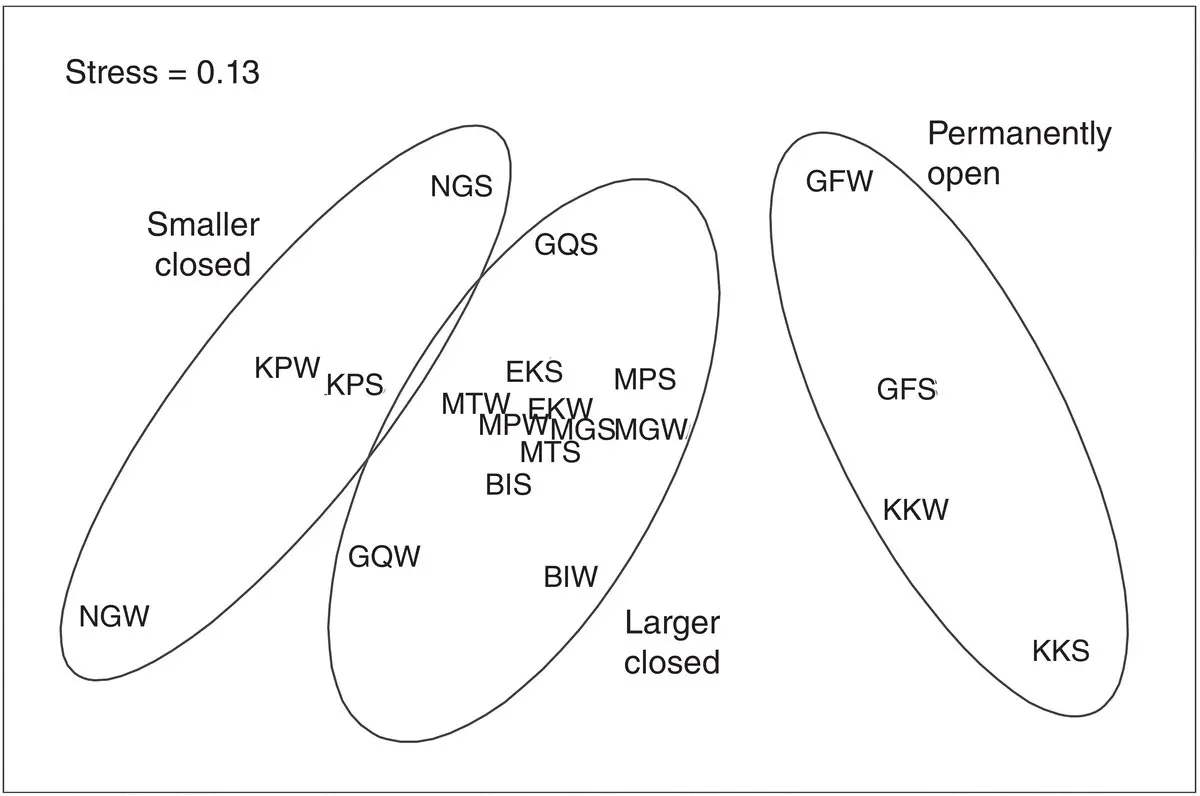
Figure 2.8 nMDS plot of the estuarine fish assemblage data from the Eastern Cape Province, South Africa (after Vorwerk et al. 2003). The circled groups indicate estuaries with significantly different communities representing permanently open and small and large temporarily open/closed systems. Each sample is represented by a three‐letter code; the first two letters are an estuary code (BI = Bira, EK = East Kleinemonde, GF = Great Fish, GQ = Gqutywa, KK = Keiskamma, KP = Klein Palmiet, MG = Mgwalana, MP = Mpekweni, MT = Mtati, NG = Ngculura) and the third letter is a season code (S = Summer, W = Winter).
Similarly, estuarine type is also known to influence the fish fauna of south‐western Australian estuaries (Potter & Hyndes 1999, Tweedley et al. 2016). To illustrate this, in detail, data on the density of fish species from the nearshore waters of 15 south‐western Australian estuaries (Tweedley et al. 2017) were used to construct a Bray‐Curtis resemblance matrix and subjected to nMDS ordination and ANOSIM tests. When based on presence/absence fourth‐root transformed abundances, faunal composition differed with estuary type, i.e. permanently open (PO), intermittently open (IO), seasonally open (SO) or normally closed (NC) (Global R = 0.882; P = 0.1% and Global R = 0.806; P = 0.1%, respectively). On the associated nMDS plots, the estuaries from each type form discrete groups and progress across the plot from left to right in order of the decrease in the duration of opening ( Figure 2.9a, b).
Permanently open estuaries contained the largest numbers of species (typically >40), and this declined to ~30 and ~25 in IO and SO systems, respectively, and generally ≤7 in NC estuaries ( Figure 2.9c, d). Although all estuaries contained a core suite of estuarine species (i.e. E, EF and EM), the number of marine species (MS and MEO) were far lower in IO and SO than PO estuaries and were almost absent in NC systems ( Figure 2.9e, f). This reflects the reduced connectivity with the ocean and the lack of opportunity for marine species to recruit and the fact that NC estuaries can often become markedly hypersaline (Hoeksema et al. 2018). When based on abundance, marine species, typically the juveniles of MEO taxa, can make a relatively large contribution to fish fauna of some permanently open estuaries (e.g. up to 45% in the Peel‐Harvey), with stragglers, by definition, making a very minor contribution (average in PO systems of 1.4% all fish; Figure 2.9e–h). Thus, the vast majority, i.e. 54–99.99%, of the fish in each system belong to the estuarine category. The contribution of the component guilds differed, however, among estuary type, with the proportion of EM species being 33% in PO systems vs 11 in SO and only 2 and 0.8% in IO and NC estuaries, respectively. In contrast, EF species numerically dominated IO systems (average = 67%), as these systems tend to be oligohaline, and E species, some of which have remarkable tolerances to salinity, dominated NC estuaries (average = 83%).
When it comes to assessing the dominant drivers governing the composition of estuarine fish assemblages, it would appear that biogeographical factors are very important. In this regard, an overall analysis based on the composition of the estuarine ichthyofauna in South African estuaries by Harrison & Whitfield (2008) revealed a tendency for subtropical, warm‐temperate and cool‐temperate systems to group together, regardless of estuary type. These findings place a whole new perspective on the role of estuarine typology versus biogeography, one that continues to influence our understanding of the structuring and functioning of fish assemblages in estuaries.
2.4 Fish guilds and functional groups
Many studies have dealt with the taxonomic entities within estuaries, i.e. the species composition of fish assemblages and their seasonal and spatial variation (e.g. Potter et al. 1997, Yáñez‐Arancibia et al. 1988, Marshall & Elliott 1998, Nordlie 2003, Albaret et al. 2004, Ecoutin et al. 2005, Able & Fahay 2010). However, with increasing knowledge of the fish species occupying estuaries, scientists were then able to group them according to their life history patterns ( Figure 2.10).
Several studies have concentrated on a functional analysis of community structure in which the species present are assigned to groupings or guilds, each of which denotes certain attributes. For example, Albaret (1999) used bioecological categories, essentially guilds, to define and compare the fundamental estuarine fish community. Thus guilds, or equivalent terminology, have been used to provide information on the functioning, hierarchical structure and connectivity of estuaries, and to simplify our ecological understanding of complex ecosystems (Elliott & Dewailly 1995, Garrison & Link 2000, Lobry et al. 2003, Franco et al. 2006, Potter et al. 2016, Nickerson et al. 2018).
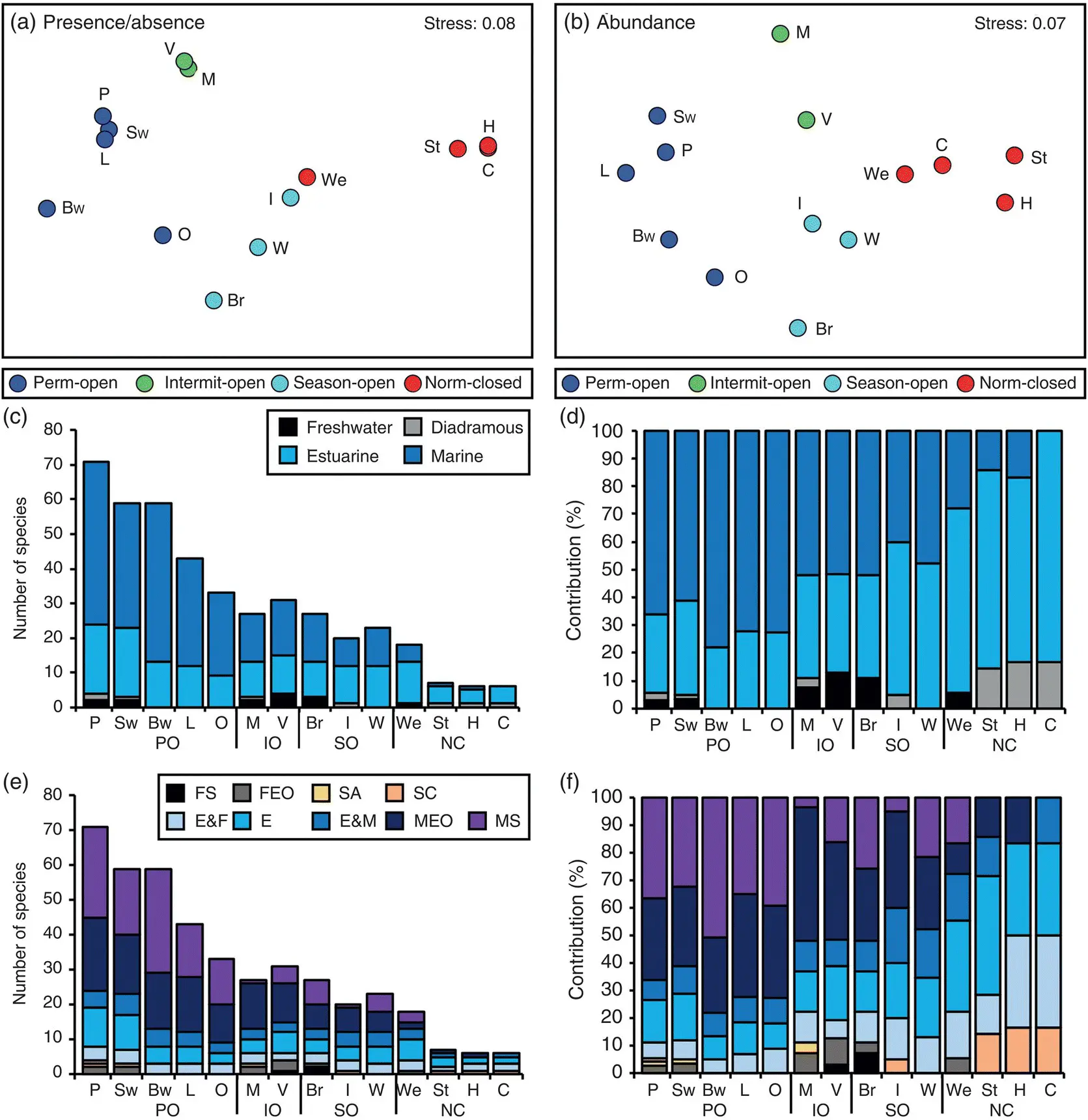

Figure 2.9 Ordinations (nMDS) derived from (a) presence/absence and (b) abundance of fish species from the nearshore waters of 14 south‐western Australian estuaries (after Tweedley et al. 2017). Stack bar graphs of the number and percentage contribution of species (e–f) and density and percentage contribution (g–j) of fish by both EUFG category and guild. EUFG: MS = marine straggler, MEO = marine estuarine‐opportunist, E&M = estuarine & marine, E = solely estuarine, E&F = estuarine & freshwater, SC = semi‐catadromous, SA = semi‐anadromous, FEO = freshwater estuarine‐opportunist, FS = freshwater straggler. Estuaries: P = Peel‐Harvey, Sw = Swan‐Canning, Bw = Blackwood, L = Leschenault, O = Oyster, M = Moore, V = Vasse‐Wonnerup, Br = Broke, I = Irwin, W = Wilson, We = Wellstead, St = Stokes, H = Hamersley, C = Culham. Estuary type: PO = permanently open, IO = intermittently open, SO = seasonally open, NC = normally closed.
The concept of guilds was first developed for fishes inhabiting estuaries in the early classical works by McHugh (1967), Cronin & Mansueti (1971), Perkins (1974), Haedrich (1983) and Wallace et al. (1984), all of whom separated the components of the estuarine nekton into ecological groupings. The concept was also used by de Sylva (1975) and Whitfield (1980b) who defined groupings of estuarine fishes based on their feeding preferences and food web structure. This type of analysis was then extended to include descriptions of the migration, reproduction and habitat preferences of species (e.g. Potter et al. 1990, Whitfield 1990, Elliott & Dewailly 1995).
Prior to a review by Elliott et al. (2007), the approach to classifying fish into categories and guilds in terms of the way they use estuaries varied considerably according to individual biogeographic areas and types of estuaries, as well as the variety of available terms. These authors developed a classification scheme that is a logical extension of previous conceptual models and which focusses especially on a revision and standardisation of previous categorizations. It also draws out those cases where the classification of a particular guild has to be adapted to meet differences between the fish faunas in very different regions (e.g. temperate versus tropical) or where new information necessitates the creation of additional categories or a revision of existing categories.
Читать дальше
